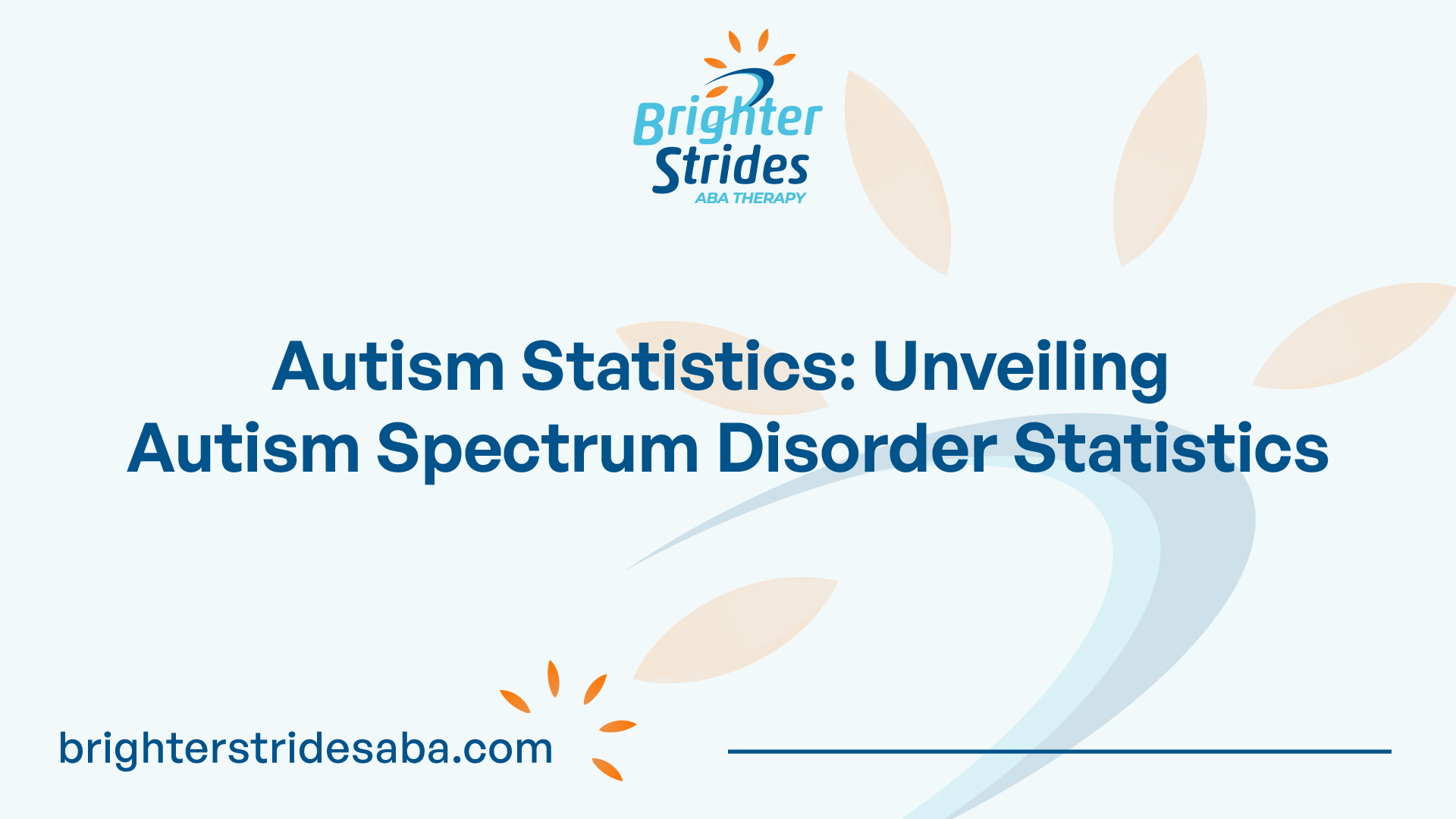Understanding Autism Spectrum Disorder
Autism Spectrum Disorder (ASD) is a complex neurodevelopmental condition that affects individuals’ social communication and behavior. It is characterized by a range of challenges and strengths that vary from person to person. To better comprehend the impact and significance of ASD, it is important to delve into what it entails and understand its prevalence. Here are Top 10 Key Statistics about Autism Spectrum Disorder:

- According to the Centers for Disease Control and Prevention (CDC), approximately 1 in 54 children in the United States is diagnosed with ASD.
- Boys are nearly four times more likely to be diagnosed with ASD than girls.
- The prevalence of ASD has increased dramatically over the past few decades, but it is unclear whether this is due to increased awareness and diagnosis or a true increase in incidence.
- Children with ASD often have other co-occurring conditions, such as anxiety, depression, or ADHD.
- Early intervention can make a significant difference in the outcomes for individuals with ASD.
- There is no one definitive cause of ASD; rather, it likely involves a combination of genetic and environmental factors.
- Many adults with ASD are undiagnosed and may struggle with employment, relationships, and daily living skills without proper support and accommodations.
- Individuals with ASD often have unique strengths and abilities, such as exceptional memory or attention to detail.
- Research into effective treatments for ASD is ongoing, but currently there is no cure for the condition.
- Autism acceptance and neurodiversity movements are gaining momentum, promoting understanding and inclusion of individuals on the spectrum in society.
What is Autism Spectrum Disorder?
Autism Spectrum Disorder, as defined by Autism Speaks, is estimated to affect 1 in 54 children in the United States based on 2016 data from the Centers for Disease Control and Prevention (CDC). It is a lifelong condition that typically manifests during early childhood and continues throughout adulthood.
Individuals with ASD may experience difficulties in social interaction, communication, and exhibit repetitive patterns of behavior and interests. They may also have sensory sensitivities. It is important to note that individuals with ASD have unique strengths and abilities as well, and their experiences and challenges can vary widely.
Prevalence of Autism Spectrum Disorder
The prevalence of Autism Spectrum Disorder among children in the United States has been steadily increasing. According to the latest data from 2020 provided by the CDC, the prevalence rate stands at 1 in 54 children. A survey conducted by the CDC indicates that approximately 1 in 59 children in the United States have been diagnosed with ASD.
The prevalence rate of ASD in the general population is estimated to be around 1-2%. Data from the Autism and Developmental Disabilities Monitoring Network suggests that the prevalence of ASD among children aged 8 years was calculated to be 1.7% in the United States in 2020.
It is important to note that the prevalence rates may differ across countries and regions. Factors such as diagnostic criteria, screening practices, and awareness levels can contribute to these variations.
Understanding the prevalence of Autism Spectrum Disorder provides valuable insights into the scope and impact of this condition. By gaining a better understanding of ASD, we can strive to create a more inclusive and supportive environment for individuals on the autism spectrum.
Demographics and Autism Spectrum Disorder
When examining the demographics of individuals with Autism Spectrum Disorder (ASD), it is important to consider factors such as gender and racial/ethnic disparities. Understanding these demographics can provide valuable insights into the prevalence and distribution of ASD.
Gender and Autism Spectrum Disorder
ASD is more commonly diagnosed in boys than in girls, with a prevalence rate of approximately 1 in 34 boys compared to 1 in 144 girls in the United States CDC. Boys are four times more likely to be diagnosed with ASD than girls, according to Autism Speaks.
The reasons behind this gender disparity are still being studied, and researchers continue to explore potential genetic and biological factors that may contribute to the higher prevalence in boys.
Racial and Ethnic Disparities in Autism Spectrum Disorder
ASD prevalence rates can vary among different racial and ethnic groups. In the United States, ASD is most prevalent among non-Hispanic white children compared to black and Hispanic children Autism Speaks. However, it is important to note that this does not mean that ASD does not occur in other racial and ethnic groups. The prevalence rates may reflect disparities in access to diagnosis and services, as well as potential cultural and socioeconomic factors that influence identification and reporting.
Examining the demographics of ASD helps shed light on the unique challenges faced by different groups within the autism community. By understanding these disparities, researchers, policymakers, and healthcare professionals can work towards improving access to diagnosis, interventions, and support for individuals with ASD across all demographic groups.
Characteristics of Autism Spectrum Disorder
Autism Spectrum Disorder (ASD) is a complex neurodevelopmental disorder that is characterized by a range of challenges in social interaction, communication, and restricted and repetitive behaviors. In this section, we will explore two important characteristics of ASD: intellectual disability and the importance of early intervention.
Intellectual Disability and Autism Spectrum Disorder
Approximately 31% of children with ASD have an intellectual disability, according to Autism Speaks. Intellectual disability refers to significant limitations in both intellectual functioning and adaptive behavior. It can affect a person’s ability to learn, communicate, and perform daily activities independently.
It’s important to note that not all individuals with ASD have an intellectual disability. Some individuals with ASD may have average or above-average intelligence. The severity of intellectual disability can vary widely among individuals with ASD. Early intervention and appropriate support can help individuals with ASD, regardless of their intellectual abilities, reach their full potential.
Early Intervention for Autism Spectrum Disorder
Early intervention refers to the services and support provided to children with ASD during their early developmental years. Studies have shown that early intervention can lead to significantly improved outcomes for children with autism, making early diagnosis crucial. Intervening early helps address the core challenges associated with ASD and supports the development of social, communication, and cognitive skills.
Early intervention services may include therapies such as applied behavior analysis (ABA), speech and language therapy, occupational therapy, and social skills training. These interventions are tailored to the individual needs of each child and are often implemented in a structured and supportive environment.
The median age at which children with ASD start receiving early intervention services is 4 years and 7 months, as reported by the CDC. However, it is important to strive for even earlier identification and intervention to maximize the benefits. Early intervention and treatment can greatly improve outcomes for individuals with ASD, enhancing their development, social interactions, and overall quality of life.
Understanding the characteristics of ASD, such as the presence of intellectual disability and the importance of early intervention, helps create awareness and promote the necessary support and resources for individuals with ASD and their families. By providing early intervention services, we can positively impact the lives of individuals with ASD and help them thrive.
Trends in Autism Spectrum Disorder
As we delve into the statistics surrounding Autism Spectrum Disorder (ASD), it becomes evident that there are notable trends in terms of prevalence and age of diagnosis.
Increasing Prevalence of Autism Spectrum Disorder
The prevalence of ASD has been steadily increasing over the past few decades. The latest data from 2020 shows a prevalence rate of 1 in 54 children in the United States, indicating a significant rise compared to previous years. This increase highlights the growing recognition and diagnosis of individuals on the autism spectrum (CDC).
Age of Diagnosis for Autism Spectrum Disorder
Early diagnosis and intervention play a crucial role in improving outcomes for individuals with ASD.
The average age of diagnosis for children with autism is currently around 4 years old, although some children can be diagnosed as early as 2 years old Research suggests that early intervention can lead to significantly improved outcomes, making early diagnosis essential.
It is important to note that the age of diagnosis varies among different individuals. While some children may receive a diagnosis at a young age, others may not be diagnosed until later in childhood. Prompt recognition of developmental concerns and early screening can help identify children who may benefit from further evaluation for ASD.
By understanding the increasing prevalence of ASD and the importance of early diagnosis, we can better support individuals on the autism spectrum and promote a more inclusive society. The statistics surrounding autism spectrum disorder provide valuable insights into the trends and characteristics of this complex neurodevelopmental condition.
Economic Impact of Autism Spectrum Disorder
Autism Spectrum Disorder (ASD) not only affects individuals and their families emotionally and socially but also has a significant economic impact. The costs associated with supporting individuals with ASD can be substantial. In the United States alone, estimates range from $61 billion to $66 billion per year.
The economic impact of ASD stems from various factors, including healthcare expenses, educational support, therapy, and other services tailored to meet the specific needs of individuals with ASD. These costs can place a financial burden on families and communities, highlighting the importance of understanding and addressing the economic challenges associated with ASD.
To better understand the economic impact of supporting individuals with ASD, let’s explore the cost considerations involved.
The Cost of Supporting Individuals with Autism Spectrum Disorder
The financial burden of supporting individuals with ASD can vary based on factors such as the severity of symptoms, required interventions, and access to services. The costs associated with ASD can be categorized into several areas:
- Medical Expenses: Individuals with ASD may require regular medical evaluations, specialized assessments, and treatments. These medical expenses can include doctor visits, medication, and specialized therapies.
- Educational Support: Providing appropriate educational support for individuals with ASD is essential. This can involve tailored educational programs, individualized teaching methods, and support from special education professionals. Additional costs may include assistive technology, behavioral interventions, and educational materials.
- Therapies and Interventions: Individuals with ASD often benefit from various therapies, such as speech and language therapy, occupational therapy, and behavioral therapy. These therapies aim to enhance communication skills, social interactions, and overall functioning. The costs associated with these therapies can add up over time.
- Support Services: ASD support services encompass a wide range of interventions, including social skills training, vocational training, and residential supports. These services aim to improve the quality of life for individuals with ASD and provide assistance with independent living.
- Caregiver Expenses: The responsibilities and demands on caregivers of individuals with ASD can be significant. Caregiver expenses may include lost wages due to reduced work hours, transportation costs, and respite care services to alleviate caregiver stress and provide temporary relief.
It is important to note that the economic impact of ASD extends beyond individual families, affecting the healthcare system, educational institutions, and society as a whole. Understanding the economic implications of ASD helps inform policymakers, healthcare providers, and organizations in allocating resources effectively.
By recognizing the economic challenges faced by individuals and families affected by ASD, society can work towards providing comprehensive support, affordable services, and greater accessibility to ensure a better quality of life for individuals with ASD and their families.
Genetic Factors and Autism Spectrum Disorder
Autism Spectrum Disorder (ASD) is influenced by a combination of genetic and environmental factors. Understanding the genetic contributions and environmental influences can provide valuable insights into the development of ASD.
Genetic Contributions to Autism Spectrum Disorder
Genetic factors play a significant role in the development of ASD. Studies have shown that certain genes and genetic variations are associated with an increased risk of ASD. However, it’s important to note that no single gene is solely responsible for causing ASD. Rather, it is believed that multiple genes interact with each other and with environmental factors to contribute to the development of ASD.
Research has identified several genes that are commonly associated with ASD. These genes are involved in various aspects of brain development and functioning. However, it’s essential to recognize that genetic factors alone do not account for all cases of ASD. Other factors, such as environmental influences, also play a role.
Environmental Factors and Autism Spectrum Disorder
While genetic factors are important, environmental influences also contribute to the development of ASD. Environmental factors encompass a wide range of influences, including prenatal and early-life exposures.
Research suggests that prenatal factors, such as maternal infections, exposure to certain medications or chemicals during pregnancy, and maternal health conditions, may contribute to the risk of ASD. Additionally, complications during pregnancy or birth, such as prematurity or low birth weight, have also been associated with an increased likelihood of ASD development.
It’s important to note that the interplay between genetic and environmental factors in the development of ASD is complex and not yet fully understood. More research is needed to unravel the intricate connections between genes, environmental factors, and the development of ASD.
Understanding the genetic and environmental factors involved in ASD is crucial for advancing our knowledge of the disorder. By identifying these factors, researchers and healthcare professionals can work towards developing targeted interventions and treatments to support individuals with ASD.
Conclusion
As we’ve explored in this article, Autism Spectrum Disorder (ASD) is a complex neurodevelopmental disorder with significant impacts on individuals, families, and society as a whole. From understanding the characteristics of ASD to exploring the economic implications and genetic factors involved, there is much we can learn about this condition.
It’s clear that early intervention and support for individuals with ASD is crucial for improving outcomes. By recognizing the importance of early diagnosis and providing tailored interventions, we can help individuals with ASD reach their full potential.
Acknowledging the disparities in access to diagnosis and support across different demographic groups is essential for promoting a more inclusive society. By working towards greater accessibility and support for all individuals with ASD, we can ensure that no one is left behind.
Overall, by continuing to explore the trends, characteristics, economic impact, and genetic factors of ASD, we can better understand this complex condition and work towards creating a more supportive and inclusive world for individuals with ASD and their families.
Sources
- https://www.autismparentingmagazine.com/autism-diagnosis-average-age/
- https://www.cdc.gov/ncbddd/autism/addm-community-report/delay-to-accessing-services.html
- https://www.cdc.gov/ncbddd/autism/data.html




